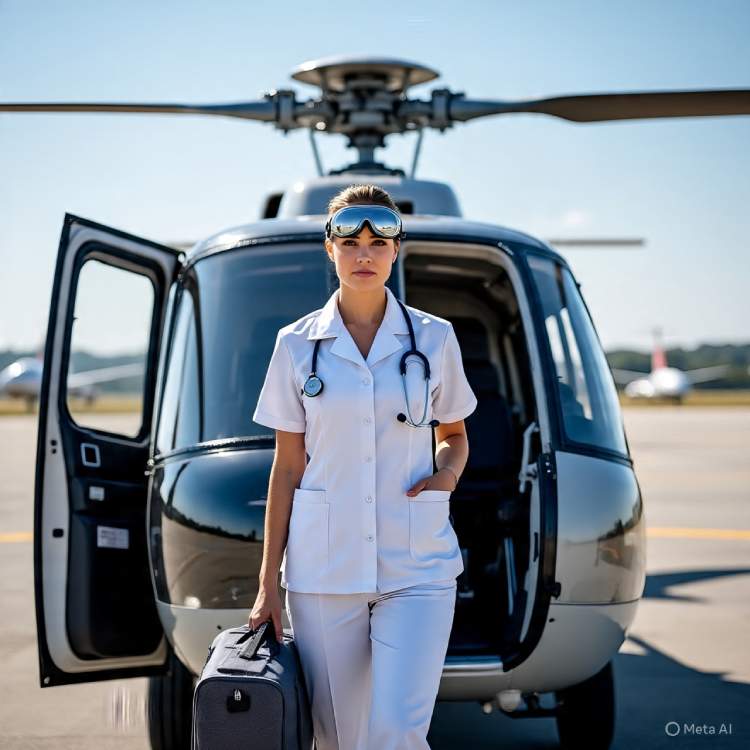How to Become a Flight Nurse in US 2025 – Step-by-Step Career Guide to This High-Paying, Exciting Nursing Job
how to become a flight nurse in US 2025 – step-by-step?

Wondering how to become a flight nurse in US 2025 – step-by-step? You’re in the right place. A flight nurse is a highly skilled registered nurse who provides critical care in emergency situations—often in helicopters or fixed-wing aircraft. These nurses are trained to save lives mid-air, transporting trauma victims and critically ill patients from accident scenes or remote locations to advanced hospitals. If you’re a nurse who thrives under pressure and wants to work in one of the most adrenaline-filled, high-paying nursing specialties, flight nursing might be your dream job.

More than 550,000 patients in the U.S. depend on air ambulances each year, and flight nurses play a life-or-death role in these missions. Whether stabilizing a car crash victim during a mountain rescue or transporting a premature newborn to a neonatal ICU, these nurses act fast, think critically, and often make autonomous decisions thousands of feet above ground.
This complete guide will walk you through how to become a flight nurse in US 2025 – step-by-step. You’ll learn what flight nurses do, how much they earn, the education and certifications you’ll need, pros and cons of the job, and how to land your first role. Whether you’re a new RN or a seasoned ICU nurse looking to level up, this resource will help you decide if taking your nursing skills to the skies is your next move.
What Is a Flight Nurse?
A flight nurse is a highly skilled registered nurse (RN) who delivers emergency and critical care to patients during air medical transport, whether by helicopter or fixed-wing aircraft. These nurses play a vital role in stabilizing patients mid-flight while en route to hospitals or trauma centers.
While all flight nurses are licensed RNs, their role is far different from that of hospital-based nurses. They work in airborne intensive care units, often autonomously performing advanced procedures that might normally require a physician’s presence in a hospital. They fly alongside paramedics or emergency physicians, providing life-saving care in high-pressure environments.
How to Become a Flight Nurse in US 2025 – Step-by-Step
If you’re wondering how to start a career in flight nursing, here’s a step-by-step breakdown from student to certified flight nurse.
1. Earn a Nursing Degree (ADN or BSN)
Start by enrolling in an accredited nursing program. You can choose between an Associate Degree in Nursing (ADN), which takes about 2–3 years, or a Bachelor of Science in Nursing (BSN), which takes around 4 years.
Tip: Many flight nurse employers prefer BSN-prepared nurses due to their stronger clinical foundation and leadership skills. Focus on core nursing areas like anatomy, pharmacology, and emergency care during your training.
2. Pass the NCLEX-RN and Obtain Licensure
After graduation, you’ll need to pass the NCLEX-RN, the national licensing exam for nurses. This computer-based exam consists of roughly 75–145 questions and costs around $200.
Once you pass, apply for licensure through your state board of nursing. With your RN license secured, you’re officially ready to begin working.
Education and Licensure Timeline
| Stage | Typical Duration | Requirements & Milestones |
|---|---|---|
| Nursing Education (ADN or BSN) | ADN: 2–3 years BSN: ~4 years | Graduate from an accredited program. Complete all clinicals and coursework in nursing fundamentals. |
| NCLEX-RN & Licensure | ~1–3 months | Pass NCLEX-RN. Apply for your state’s RN license. May include background check and jurisprudence exam. |
| Critical Care RN Experience (ICU/ER) | 3–5 years | Work in ICU, ER, or trauma unit. Master ventilator use, trauma care, IV therapy, and cardiac emergencies. Earn BLS, ACLS, and PALS. |
| Specialty Certifications | Eligible after ~2 years of ICU/ER work | Earn certifications like CCRN or CEN. Prepare for the CFRN exam (flight-specific). Many employers require it within 1–2 years. |
| Job Application & Flight Training | Varies (usually months) | Apply to programs, complete interviews, pass physical/agility tests. Finish flight orientation and safety training (~4–8 weeks). |
| Ongoing Education | Lifelong | Renew your license and certifications regularly. Attend skills labs, CE courses, and transport nursing conferences. |
3. Gain 3–5 Years of Critical Care RN Experience
To be competitive, you’ll need 3–5 years of hands-on RN experience in high-acuity settings like emergency rooms (ERs), intensive care units (ICUs), or trauma centers.
This is where you sharpen essential skills like managing ventilators, responding to codes, performing emergency interventions, and working with a wide range of critical conditions—including multi-system trauma and cardiac arrest.
4. Get Advanced Nursing Certifications
While you’re working in the ICU or ER, start earning specialty certifications. These validate your clinical expertise and are often required:
-
CCRN – Critical Care Registered Nurse (for ICU nurses)
-
CEN – Certified Emergency Nurse (for ER nurses)
-
ACLS, PALS, NRP – Advanced life support certifications for adults, kids, and newborns
-
CFRN – Certified Flight Registered Nurse (gold standard for flight nurses; often required within 1–2 years of hire)
5. Apply for Flight Nurse Positions
Make sure you meet all job requirements before applying. Most programs expect:
-
Excellent physical fitness (you’ll be lifting patients and equipment)
-
Ability to tolerate altitude, confined spaces, and rapid stress
-
Clear communication via radio with pilots and ground staff
Look into hospital-based flight teams (like Life Flight), private air ambulance services, or military units. Build your résumé to highlight ICU/ER experience, trauma cases, and your certifications. Join organizations like ASTNA (Air & Surface Transport Nurses Association) for job opportunities and networking.
6. Complete Flight Orientation & Training
Once hired, your new journey begins with intensive orientation and flight training, including:
-
Aircraft safety protocols
-
Flight physiology (how altitude affects the human body)
-
Survival training for emergency landings
-
Equipment use (monitors, ventilators, airway tools)
You’ll also fly with a preceptor (experienced flight nurse) for several weeks or months before operating independently. Continuing education and regular simulations are part of maintaining your readiness.
How Long Does It Take to Become a Flight Nurse?
From the moment you start nursing school, expect the full process to take at least 6–8 years, including:
-
2–4 years in school
-
Passing the NCLEX
-
3–5 years of critical care experience
-
Additional months for certification, application, and training
Cost to Become a Flight Nurse in 2025
If you’re planning your journey on how to become a flight nurse in 2025, it’s important to factor in the total cost of education, licensing, and certification. The largest expense is nursing school tuition. A Bachelor of Science in Nursing (BSN) program can range from $20,000 to $80,000 at a public university, and up to $120,000 at a private college.

You can reduce costs by starting with an Associate Degree in Nursing (ADN), which typically costs less and takes less time. In-state tuition at public schools, scholarships, tuition reimbursement, and military programs like ROTC can also significantly reduce or eliminate your expenses.
Breakdown of Flight Nurse Education & Certification Costs
| Expense | Typical Cost | Details |
|---|---|---|
| Nursing Degree (ADN or BSN) | ADN: ~$6,000–$20,000 BSN: ~$20,000–$80,000 (public) Up to $120,000 (private) | Tuition depends on school type, location, and whether you qualify for in-state rates. |
| NCLEX-RN Exam | $200 | Standard national licensing exam to become a registered nurse. One-time fee. |
| State RN Licensure | ~$100 | Varies by state ($50–$200). May include background check and fingerprinting. |
| Specialty Certification Exams (CCRN, CFRN, CEN) | ~$300–$400 per exam | Certifications are strongly preferred by employers. The CFRN (flight nurse credential) costs ~$350. |
| License Renewal & Continuing Education (CE) | $60–$150 every 2 years | Many CE courses are free or employer-funded. Certification renewals may require CE hours or renewal fees. |
Money-Saving Tips:
-
Many hospitals offer tuition reimbursement for nurses seeking BSNs or advanced certifications.
-
Flight programs may cover the cost of your CFRN exam and offer pay raises for certified nurses.
-
Consider online RN-to-BSN bridge programs if you started with an ADN—they’re often more affordable and flexible.
-
Military service or scholarships can fully fund your nursing education in exchange for post-grad service.
What Flight Nurses Actually Do

Becoming a flight nurse isn’t just about flying—it’s about delivering ICU-level care in the air with limited time and space. These nurses handle critical patients mid-transport, whether from accident scenes, rural hospitals, or disaster zones. Here’s what the job really involves:
1. In-Flight Clinical Responsibilities
Flight nurses perform advanced procedures and monitor patients with life-threatening injuries or conditions like trauma, heart attacks, strokes, or burns. Core tasks include:
-
Starting IVs and administering emergency medications
-
Managing ventilators, oxygen tanks, and blood transfusions
-
Conducting invasive procedures (e.g., intubation or assisting with chest tubes)
-
Monitoring vital signs, neurological status, and cardiac rhythms
-
Completing detailed documentation during or immediately after flight
They must also inspect the aircraft’s emergency kits and equipment before every mission and work under standing orders or real-time physician guidance via radio.
2. Patient Communication & Advocacy
Even at 10,000 feet, compassion remains critical. Flight nurses:
-
Reassure anxious patients with clear, calm communication
-
Explain procedures simply (“This medication will ease your pain”)
-
Offer emotional support and a calming presence during high-stress emergencies
-
Advocate for patients’ needs when communicating with receiving hospital teams (e.g., pre-alerting for blood transfusion, trauma consults)
-
Brief families or ground staff post-flight on care provided and next steps
Scope of Practice for Flight Nurses Varies by State
As you explore how to become a flight nurse in US 2025, it’s essential to understand that your scope of practice can change depending on the state you’re flying over or landing in. Unlike standard hospital settings, flight nurses often work across state lines, and each state has its own Nurse Practice Act that governs what registered nurses (RNs) are legally allowed to do.
While most flight nurses operate under advanced standing medical protocols—often including high-level interventions like rapid sequence intubation, pain medication administration, and IV sedation—some states grant RNs more autonomy than others. For instance, in one state, a flight nurse may initiate lifesaving procedures without prior approval, while in another, direct physician authorization is required before acting.
To navigate this, air medical programs work closely with their medical directors to ensure protocols align with every state’s regulations. Understanding the scope of practice in each region is a crucial part of training if you’re learning how to become a flight nurse in US 2025. This ensures safe and legal patient care at every altitude.
Nurse Licensure Compact (NLC) & Multistate Practice
Since air ambulances regularly cross state borders, it’s important to know how licensure works. Many aspiring flight nurses wonder: Do I need a license for every state I fly into?
The answer lies in the Nurse Licensure Compact (NLC). If your home state is a Compact state, you can hold a multistate nursing license that allows you to practice in 30+ other states without having to apply for individual licenses. This is a major time- and cost-saving benefit if you’re pursuing a career as a flight nurse.
However, not all states participate. If you live or work in a non-compact state, you may need to apply for multiple single-state RN licenses, depending on your flight coverage area. Some employers may also require state-specific certifications (such as trauma certifications or EMS approvals) before allowing you to fly in certain areas.
Nurse Salary 2025 in US Breakdown: Ultimate Guide to How Much Nurses Really Make
Flight Nurse Salary in 2025 – What Can You Expect?
When considering how to become a flight nurse in US 2025, one of the most exciting motivators is the potential salary. Flight nursing offers a high-reward career—emotionally and financially—thanks to the advanced skill set and unique work environment involved.
According to the U.S. Bureau of Labor Statistics, the average RN earns about $93,600 per year. However, flight nurses often earn more, depending on their location, employer, and experience. Recent data from Payscale (2024) shows that the average annual salary for flight nurses is approximately $83,780, with many earning over $100,000—especially those working in high-cost-of-living states or in leadership roles such as Chief Flight Nurse.
Factors That Influence Flight Nurse Pay:
-
Geographic location (urban vs. rural, high-cost vs. low-cost states)
-
Type of employer (hospital systems vs. private air EMS providers)
-
Shift differentials, on-call pay, and hazard bonuses
-
Years of clinical or trauma experience
-
Additional certifications (CFRN, ACLS, PALS, etc.)
If you’re charting your path on how to become a flight nurse in US 2025, know that investing in certifications and gaining ICU or ER experience can position you for higher pay and better job offers.
Flight Nurse Job Outlook in 2025 and Beyond
The job market for flight nurses in 2025 looks promising, especially for those who are highly trained and flexible. According to the Bureau of Labor Statistics, employment for RNs is expected to grow 6% between 2022 and 2032—on par with the national average.
But what about flight nurses specifically?
While the number of flight nurse positions is limited compared to general nursing roles, demand is steady and even growing in some regions. Here’s why:
-
Rural hospitals often depend on air ambulance services to transport critically ill patients to trauma centers.
-
Increased trauma incidents, including natural disasters and road accidents, call for faster response and highly skilled transport nurses.
-
Turnover in flight nursing due to physical and emotional demands opens up new roles for trained RNs ready to take flight.
-
The growth of telehealth and mobile healthcare may increase integration with air medical transport programs, especially in underserved areas.
In short, if you’re researching how to become a flight nurse in US 2025, you’re entering a niche field with steady demand, especially for those with ICU/ER backgrounds and advanced certifications.
Professional Organizations & Resources for Aspiring Flight Nurses
If you’re learning how to become a flight nurse in US 2025 – step-by-step, getting involved with trusted professional organizations can accelerate your success. These groups offer essential resources—like certification prep, clinical guidelines, scholarships, and networking—that support every stage of your journey. Whether you’re still in nursing school or already working toward becoming a certified flight nurse, these organizations are a game-changer.
| Organization | Who They Serve | Why They Matter for Flight Nurses |
|---|---|---|
| Air & Surface Transport Nurses Association (ASTNA) | 2,000+ flight and transport nurses worldwide | ASTNA is the core organization for flight nurses. They offer discounted prep for exams like the Certified Flight Registered Nurse (CFRN), online learning, mentorship, and exclusive access to flight nursing job boards. ASTNA also shapes best practices and clinical standards. |
| Emergency Nurses Association (ENA) | 50,000+ emergency care nurses globally | If you’re exploring how to become a flight nurse in US 2025 – step-by-step, ENA provides foundational trauma education (like TNCC and CEN) that’s essential for air medical care. Members enjoy continuing education, policy advocacy, and valuable peer connections. |
| American Association of Critical-Care Nurses (AACN) | 130,000+ critical care professionals | Flight nurses often handle critically ill patients. AACN supports this with CCRN certification, deep clinical resources, research grants, and the annual NTI conference—all helping you deliver top-tier critical care mid-flight. |
| Association of Air Medical Services (AAMS) | 300+ global air transport companies & members | AAMS helps you stay on top of air medical safety, leadership training (MTLI), and transport protocols. They also advocate for improved funding and standards in air ambulance care—benefiting new and veteran flight nurses alike. |
Pro Tip: As you follow the path on how to become a flight nurse in 2025 – step-by-step, joining these organizations not only boosts your resume—it keeps you in the loop with hiring trends, advanced skills training, and real-world insights from seasoned flight RNs.
Core Skills Every Future Flight Nurse Needs
As you plan how to become a flight nurse in US 2025 – step-by-step, understand that clinical knowledge alone isn’t enough. Success in this high-pressure, fast-paced specialty also depends on mastering key personal traits:
-
Critical Thinking Under Pressure
You’ll often be the highest-level provider onboard. Being able to assess trauma cases and make rapid, high-stakes decisions is a must for any flight nurse. -
Crystal-Clear Communication
Whether coordinating with pilots or relaying vitals to a trauma team via radio, clear, calm communication saves lives. -
Adaptability in the Unknown
Air transports are unpredictable—weather delays, equipment failures, or unexpected patient complications can all arise. Flight nurses must adjust on the fly. -
Physical & Emotional Strength
From carrying patients to staying composed during pediatric or trauma cases, flight nurses need strong stamina and resilience. -
Team-Oriented with Independent Judgment
You’ll collaborate with medics and pilots, but you’ll also often lead patient care decisions. Balancing teamwork with clinical autonomy is key.
Pro Tip: Developing these traits early in your training will give you an edge as you move through each stage of becoming a flight nurse in 2025.
Ready to Launch Your Career as a Flight Nurse?
As you wrap up your journey through how to become a flight nurse in US 2025 – step-by-step, it’s time to ask: Are you ready to take your nursing skills to new heights—literally?
Becoming a flight nurse offers incredible rewards: unmatched clinical autonomy, the adrenaline of aerial rescue missions, and the power to save lives in the golden hour. You’ll work closely with elite teams, earn advanced certifications, and grow constantly—both professionally and personally.
But it’s not for everyone.
Expect long on-call hours, physically demanding flights, and emotionally intense trauma scenarios. The field is competitive, and some nurses may need to relocate to secure their first air transport position.
Still, if you’re the kind of nurse who thrives under pressure, enjoys fast-paced critical care, and dreams of making a real impact from thousands of feet above ground—this is your calling.
It’s time to earn your wings.
Follow the steps, commit to the mission, and you’ll be on your way to becoming a highly respected, high-impact flight nurse in 2025.
http://Top Nursing Certifications That Boost Your Career in 2025
http://National Council of State Boards of Nursing (NCSBN) – NLC
Frequently asked questions (FAQs)
To become a flight nurse, you’ll need an active RN license, 3+ years of ICU or ER experience, certifications like BLS, ACLS, and preferably CCRN or CFRN. A BSN is strongly recommended.
Most nurses need 5–7 years, including nursing school, licensure (NCLEX), and critical care experience before applying to flight programs.
Yes, certifications like CFRN, TNCC, ENPC, and CCEMTP boost your credentials and may be required by employers.
On average, flight nurses in the U.S. earn $83,000–$109,000 annually. Senior or specialty roles may offer higher salaries.
There are risks, including air travel conditions and trauma exposure, but safety standards and protocols are high.
Some programs accept ADN-prepared RNs, but most prefer or require a BSN and critical care credentials.
They work with air ambulances, hospital trauma teams, emergency response units, and military evacuation programs.
Yes, if they pass the NCLEX-RN, meet visa and licensure requirements, and gain U.S.-based critical care experience.




